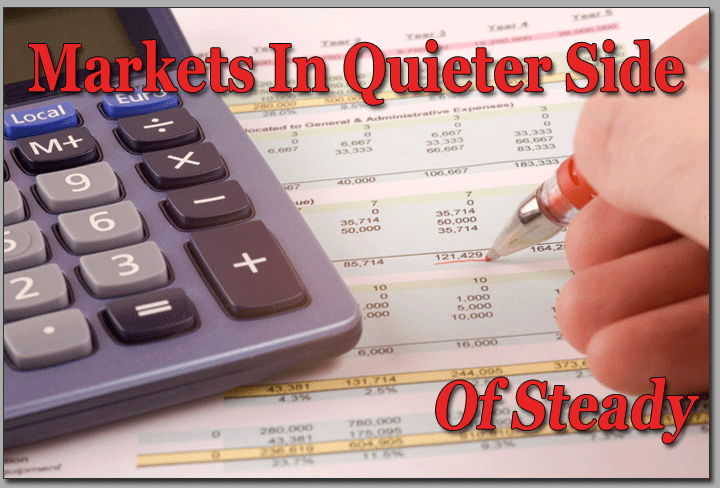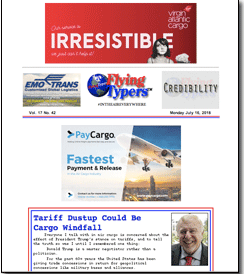 DHL’s
splurge on new aircraft reflected the ongoing
assumption of most analysts that investments
in freighters will be required in the
medium to long-term to prevent a capacity
crunch and avoid soaring charter and spot
costs. But, short-term, and despite rising
volumes, the market remains very much on the
quiet side of steady. DHL’s
splurge on new aircraft reflected the ongoing
assumption of most analysts that investments
in freighters will be required in the
medium to long-term to prevent a capacity
crunch and avoid soaring charter and spot
costs. But, short-term, and despite rising
volumes, the market remains very much on the
quiet side of steady.
New Freighters DHL
DHL Express
placed an order for fourteen Boeing 777 Freighters
earlier this month, with the delivery of the
first four expected next year. DHL also has
options for seven additional aircraft and
emphasized that while the new orders would
be capacity neutral, they would reduce exposure
to rising future costs by being fully owned
rather than leased.
“Expanding
cross-border e-commerce sales will grow to
$4.48 trillion by 2021, which means a growth
of 19.2 percent per year,” said a statement.
“DHL’s investment in the 777 Freighters
is a direct answer to the growing demand for
global express capacity.”
No
Change Flexport
However, in
the here and now, the market has shown signs
of softening. Take, for example, Flexport’s
most recent market report on July 11. The
forwarder noted that on the origins it covers—ex-China,
ex-Hong Kong, ex-Vietnam, Ex-India and SE
Asia, ex-Europe, and ex-U.S.—markets
were stable week-on-week. There had been “no
change” in rates, capacity was available
in all markets, and there was no sign of a
spike on China-U.S. lanes despite the imposition
of new tariffs.
In early July,
a spokesperson for Panalpina also told FlyingTypers
there had been no “significant changes”
in demand on U.S.-China lanes ahead of July
6 tariffs. “In fact, China production
for the quarter ended was lower than expected,”
he added.
And while latest
after-the-fact volumes from around the world
have been positive, analysts are starting
to sound more bearish now than at any time
in at least a year.
Hong
Kong Still Number One
Volumes at Hong
Kong International Airport (HKIA), the world’s
largest by international freight throughput,
rose 3.5 percent year-on-year in the first
six months of the year to total 2.5m tons.
However, in June growth slowed to just 0.9
percent year-on-year.
AAPA
Maypole
The Association
of Asia Pacific Airlines (AAPA) has only so
far released figures through to May, when
Asia Pacific airlines saw a 4.9 percent year-on-year
increase in air cargo demand measured in freight
ton kilometers. However, the average international
freight load factor declined by 1.3 percentage
points to 64.2 percent for the month, after
accounting for a faster 7.2 percent growth
in offered freight capacity.
WORLDWIDE
AIR CARGO YIELDS FELL TO A LEVEL OF USD
$1.88 IN MAY 2018, 3 PERCENT BELOW APRIL
2018, BUT STILL 14 PERCENT HIGHER THAN
IN MAY 2017
The Association of Asia Pacific Airlines |
What
About Yields?
World ACD reported
that worldwide air cargo yields fell to a
level of USD $1.88 in May 2018, 3 percent
below April 2018, but still 14 percent higher
than in May 2017. Measured in Euros, the yield
increased by 1 percent month-over-month, while
the year-over-year increase was 7 percent.
“Lots
of people have taken up the pen lately, writing
about the end of the boom, the end of the
party,” said the analyst. “Are
they all doomsday prophets, nay-sayers and
other assorted pessimists? Maybe, but sometimes
people turn out to be plain right in their
predictions, making them realists.
“Put differently:
do we experience just a small dip in growth,
or do we witness an ‘inevitable’
slide into a more modest performance of a
world economy which looked so robust only
a few months ago?”
The answer,
according to World ACD, is that there had
been a slowing of market growth in 2018 so
far, but global demand growth over the first
five months of the year was still 4.3 percent,
with the origins Chile (+58 percent), Japan
(+18 percent), Canada (+17 percent), and the
USA (+5.8 percent) particularly high performers.
The analyst
added that growth from the Americas came at
a price. “Year-on-year USD-yield improvements
in the Americas were well below 10 percent,
much lower than elsewhere in the world,”
said the report. India, Russia, and Western
Europe origins also showed negative year-on-year
growth in May.
 “The
fear of growing protectionism is real, and
that fear may well play a role in a shift
away from consumption. Will the whole world
suffer? To what extent will some regions feel
the heat of the trade war mongering more than
others?” “The
fear of growing protectionism is real, and
that fear may well play a role in a shift
away from consumption. Will the whole world
suffer? To what extent will some regions feel
the heat of the trade war mongering more than
others?”
World ACD said
that at this stage it was “impossible
to tell,” a point also picked up by
Andrew Herdman, (right) AAPA Director General.
He noted that Asia Pacific carriers enjoyed
a 5.4 percent expansion in air cargo demand
in the first five months of this year, with
volumes at high and sustained levels, but
adding that tariffs could be dampening confidence.
“Whilst
the increase in new orders across the region
is still quite encouraging, the recent escalation
in protectionist rhetoric could potentially
undermine confidence and destabilize global
trade flows,” he added. “In addition,
the operating environment for airlines is
increasingly challenging due to the impact
of higher fuel costs. Accordingly, the region’s
carriers continue to seek avenues to increase
operational efficiencies in a bid to boost
profitability.”
SkyKing
|






 Vol.
17 No. 40
Vol.
17 No. 40 Vol.
17 No. 41
Vol.
17 No. 41


 DHL’s
splurge on new aircraft reflected the ongoing
assumption of most analysts that investments
in freighters will be required in the
medium to long-term to prevent a capacity
crunch and avoid soaring charter and spot
costs. But, short-term, and despite rising
volumes, the market remains very much on the
quiet side of steady.
DHL’s
splurge on new aircraft reflected the ongoing
assumption of most analysts that investments
in freighters will be required in the
medium to long-term to prevent a capacity
crunch and avoid soaring charter and spot
costs. But, short-term, and despite rising
volumes, the market remains very much on the
quiet side of steady. “The
fear of growing protectionism is real, and
that fear may well play a role in a shift
away from consumption. Will the whole world
suffer? To what extent will some regions feel
the heat of the trade war mongering more than
others?”
“The
fear of growing protectionism is real, and
that fear may well play a role in a shift
away from consumption. Will the whole world
suffer? To what extent will some regions feel
the heat of the trade war mongering more than
others?”
 Air
Cargo News FlyingTypers reserves the right to edit all submissions
for length and content. All photos and written material submitted to
this publication become the property of All Cargo Media.
Air
Cargo News FlyingTypers reserves the right to edit all submissions
for length and content. All photos and written material submitted to
this publication become the property of All Cargo Media.